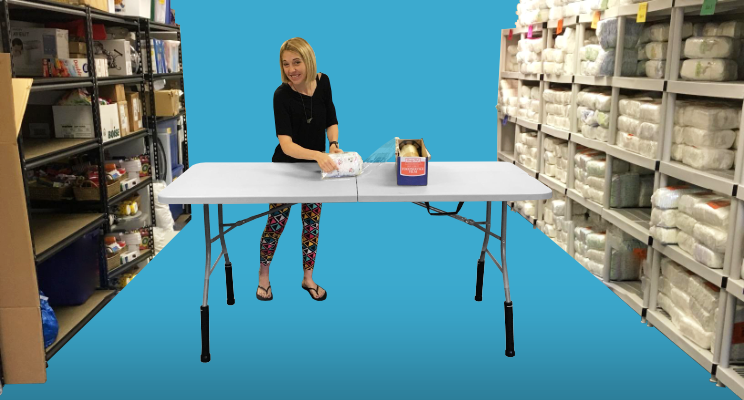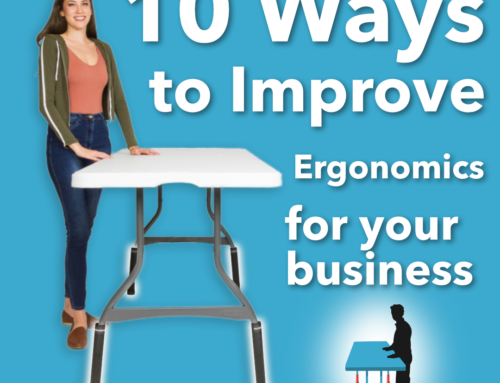When people think about safety in retail, they’re often thinking about people in the “front of the house”, whether it be for customers or employees. You’ve been in stores where the mats are put out when there’s lots of snow, when the sidewalks are de-iced, when someone’s mopping the floor to prevent slips, trips, and falls.
But workers in the back of the house, behind the glitzy storefront, are at risk of injury too.
Don’t think you need to focus on safety? In 2016 the Bureau Of Labor report found that retail workers have a higher incidence of injury and illness than construction workers do!
The more incidents you have, the higher your worker’s comp costs will be. Not to mention the cost of hiring replacement workers.
Injuries in retail
Common injuries include falling items, lifting or over-exertion, repetitive stress, and machine-related issues.
Falling items
Some warehouse shelves are stacked high, and it’s critical to keep the items stable at high levels to avoid the items falling on workers. Keeping the very heavy material at the bottom helps as well.
Yet even things that aren’t very heavy can cause damage to workers. Make sure there are procedures in place to ensure that everything is stacked in a stable way.
Lifting or over-exertion
Using proper lifting techniques, including lifting with your legs and not your back, using machines where possible, and asking for help with a team lift, is one way to prevent back injuries for retail workers.
But managers and supervisors also need to manage the loads that their workers are carrying, sometimes literally. In the summer, employees need to be able to hydrate quickly and easily, and have an air-conditioned rest space as well.
Repetitive stress
Many of these types of injuries can be prevented by simply engineering the workspace to account for ergonomics. For example, Walmart redesigned their checkout carousels to avoid putting their cashiers at risk from thousands of repetitive motions each day.
Luckily, you don’t always have to purchase new equipment to help keep your workers safe!
Take folding tables, which many retailers use in their receiving process. They’re normally too low for workers to stand at comfortably, with their spines in the correct posture. Working hunched over is bad for the back, as you can imagine.
Slide on a pair of folding table risers to lift the work surface to kitchen counter height (or higher). Employees can now stand straight to do their work, plus you don’t have to buy any new tables or equipment. (If you’ve got workers who stand at folding tables and want to help save their backs, click here for our full line of folding table risers.)
Machine-related
All employees using a specific machine must be trained on how to use it safely. Letting the last hire train the newest one is not a great idea! All the workers who use it should also have periodic refreshers, in case they’ve slipped into some bad habits.
Workers also need to be mindful around their machines. Those working on the machine must have enough space to work comfortably so no one else can get in their way or be injured while it’s in operation.
Introduce a culture of safety if you don’t already have one
This process does take a bit of time to develop, and for it to work you need buy-in at every level, from the retail floor to management. The goal is zero safety incidents in the workplace. But what works for management won’t necessarily convince workers.
If your top management has not been involved in safety culture before, you’ll need to make the case to them. Normally the cost to implement will recoup itself in reduced worker’s comp outlays, fewer call-offs and sick days, and the like. Dollars and cents are what make sense (sorrynotsorry) to company leadership.
What about introducing new safety procedures for workers, who are usually already comfortable doing it one way and don’t really want to learn a new way? Don’t just dump new trainings on them – explain how the new processes help them go home safe and sound at the end of the day.
Training
Retail workers need to be trained on safety just as construction workers are. Don’t forget to include training for part-time workers and seasonal hires, because they get hurt too.
It’s not just about machines. Workers need to know how to do every aspect of the job safely.
If you’ve got fork trucks in your warehouse, it’s not just the operators who need training. Everyone who uses that space needs training on staying outside the lanes and staying alert. How to stack safely. How to lift safely. How to make sure the space is cleared of obstructions and potential slip/fall hazards.
All workers – front of house and back – need to be trained on, and work in, a culture of safety. Reducing worker’s compensation costs often pays for the cost of implementing the necessary processes.
Need to lift the surface of your folding tables to avoid back pain and strain on your workers? Click here to see our full product line of folding table risers.
Lift Your TableⓇ… SAVE YOUR BACK!




